Does The US Torture? Public Can't See Guantanamo Bay Force Feeding Videos, Court Says

The U.S. government does not have to disclose videos of suspected terrorists being force-fed at Guantanamo Bay, a federal court ruled on Friday. The ruling reversed a lower court's decision that the public had a right to see the videos.
The U.S. Court of Appeals for the District of Columbia ruled the government had the right to keep secret 28 videos of Guantanamo Bay staff force-feeding Syrian prisoner Abu Wa’el Dhiab, citing national security concerns. In 2014, federal judge Gladys Kessler ruled the public had a right to see the videos after a group of news organizations sued to have them unsealed.
"The government identified multiple ways in which unsealing these recordings would likely impair national security," the court ruled. "Two of these risks – detainees triggering forcible encounters and developing countermeasures – together and individually, were enough to prevent these recordings from becoming public."
Read: What's Next For Guantanamo Bay? Under Trump, Cuba Prison Is 'Important Tool'
Prisoners at the Guantanamo Bay prison facility in Cuba, which the U.S. military has used to detain suspected terrorists, some for over a decade, have performed hunger strikes in order to protest treatment since at least 2005. In 2013, prisoners began widespread hunger strikes. In response the U.S. began force-feeding prisoners to keep them alive. The practice is not for the faint of heart: it involves strapping down prisoners and inserting a tube through the nose that is used to pump nutrients into the prisoner's stomach. The process can take two hours and is followed by an hour of monitoring to make sure the prisoner doesn't try to induce vomiting, according to guidelines covering the practice published by Al-Jazeera.
The World Medical Organization opposes force-feeding, as does the American Medical Association, which said the practice "violates core ethical values of the medical profession."
Kessler twice ruled against the government in the case, saying it "strained credulity" that prisoners could develop countermeasures if the videos were made public. She also called the indefinite detention of prisoners in Guantanamo a "burning, controversial issue in this country.”
News organizations became aware of the videos, which were created to help train staff on force-feeding procedures, after Dhiab filed a petition in federal court to prevent the government from force-feeding him. Dhiab's attorney was able to gain access to the videos, and filed them in court under seal.
Dhiab was later released to Uruguay in 2014 after being held in Guantanamo for 12 years, and then traveled to Venezuela.
The Guantanamo Bay facility has held over 700 suspected terrorists and people with terrorist ties since Sept. 11, 2011. President Barack Obama failed to fulfill a campaign promise to close the facility, but he was able to reduce the prisoner population to 41 by the time he left office, down from a high of 684 detainees in June 2003. President Donald Trump's administration has called the facility "a critical tool in the fight against international radical Islamist groups."
In 2013, musician and actor Yasiin Bey, formerly known as Mos Def, agreed to undergo the procedure on camera to educate the public about the practice.
© Copyright IBTimes 2025. All rights reserved.






















